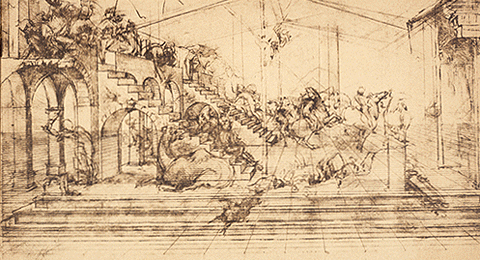
Linear perspective is a mathematical system for creating the illusion of space and distance on a flat surface. The system originated in Florence, Italy in the early 1400s. The artist and architect Brunelleschi demonstrated its principles, but another architect and writer, Leon Battista Alberti was first to write down rules of linear perspective for artists to follow. Leonardo da Vinci probably learned Alberti's system while serving as an apprentice to the artist Verrocchio in Florence.
To use linear perspective an artist must first imagine the picture surface as an "open window" through which to see the painted world. Straight lines are then drawn on the canvas to represent the horizon and "visual rays" connecting the viewer's eye to a point in the distance.
The horizon line runs across the canvas at the eye level of the viewer. The horizon line is where the sky appears to meet the ground.
The vanishing point should be located near the center of the horizon line. The vanishing point is where all parallel lines (orthogonals) that run towards the horizon line appear to come together like train tracks in the distance.
Orthogonal lines are "visual rays" helping the viewer's eye to connect points around the edges of the canvas to the vanishing point. An artist uses them to align the edges of walls and paving stones.

